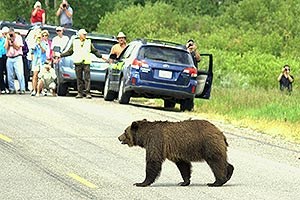
Photo by B. Scates
Like people, bears require food, water, shelter, and space to survive. As large animals, bears also require large tracts of open space to roam, feed, and rear their young, making them vulnerable to threats from many different sources.
Activities such as development, logging, mining, and road construction can fragment bear habitat into smaller, disconnected areas that don’t offer sufficient space or food. Rapidly warming temperatures are reducing sea ice in the Arctic, which provides primary habitat for polar bears to hunt and raise their young. Habitat loss is the biggest threat to all three types of bears in the United States.
At the same time, conservation measures and changes in land use have started to allow brown and black bear populations to rebound in certain areas. In these places, increasing bear populations and isolated areas of habitat are pushing bears toward populated areas, including developed areas in parks. As bears try to adapt to living near people, interactions between bears and people increase. These interactions take many forms. Some bears learn to associate places people live or use with unattended food, and that these are good places to forage for food. This can result in unwanted physical contact between people and bears. When bears pose a threat to humans or their property, they may be relocated or even killed. Unfortunately, relocation often fails when the bear returns or continues to seek out human food in other places and then must be euthanized. Other bears are victims of car accidents, even in national parks such as Yosemite where managers place traffic signs reading “speeding kills bears” along roadsides.
These human-bear interactions are further complicated when the availability of natural food sources is low. Weather patterns such as a drought or severe winters can diminish seasonal foods. Decreased availability of natural food can drive bears toward human spaces looking for food, such as fruit trees, birdfeeders, and garbage. In addition, climate change alters the timing and availability of bears’ traditional food sources such as berries and pine nuts. Exotic species, pesticides, and illegal fishing also affect food availability for bears.
The national parks provide important refuges for bears, where they can find natural food sources and sufficient habitat to remain wild. National Park Service staff are working to understand and protect bears from these threats by performing research and working with partners. You, too, can help protect bears. Learn how to get involved.
Last updated: March 11, 2016
